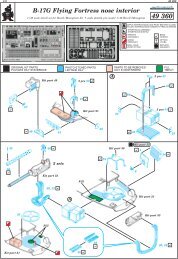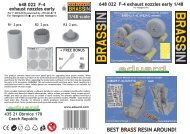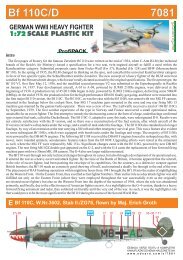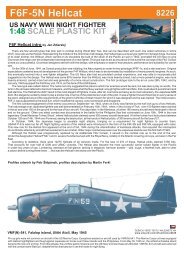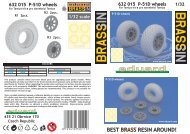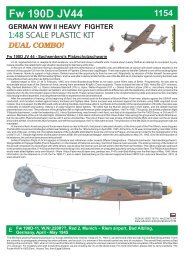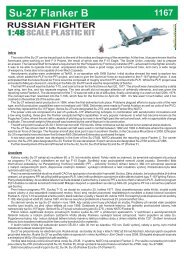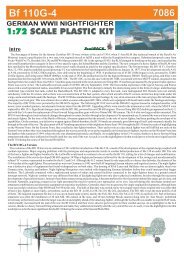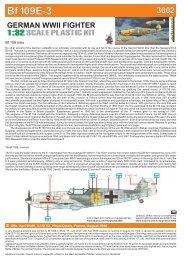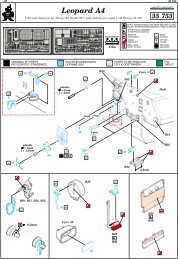US NAVY WWII FIGHTER F6F-3 Hellcat 7076 - Eduard
US NAVY WWII FIGHTER F6F-3 Hellcat 7076 - Eduard
US NAVY WWII FIGHTER F6F-3 Hellcat 7076 - Eduard
- No tags were found...
Create successful ePaper yourself
Turn your PDF publications into a flip-book with our unique Google optimized e-Paper software.
<strong>F6F</strong>-3 <strong>Hellcat</strong> <strong>7076</strong><strong>US</strong> <strong>NAVY</strong> <strong>WWII</strong> <strong>FIGHTER</strong>1:72 SCALE PLASTIC KITintroThere are few aircraft types that took part in combat during World War Two, that can be described with such one sided outcomes in terms of kill : loss ratio asthe <strong>Hellcat</strong>. Representing the middle of the Grumman Cat lineage, the <strong>Hellcat</strong> was a unique type right from its beginnings. Success of its older brother, theWildcat, which carried on its shoulders the bulk of the strain of the Pacific air war in 1942, prompted the <strong>US</strong> Navy to give Grumman free reign over theindependent development of a new fighter. This type was to act as insurance in the event the concept of the F4U Corsair turned out unsuccessful. Grummandesigners set forth with the design, with emphasis on ease of manufacture, performance and suitability for carrier ops. On the 30th of June, 1941, as Corsairproduction was initiating, the Navy signed an order for two prototype X<strong>F6F</strong>-1s, and a star was born. Original expectations centered around development of theproven F4F Wildcat, which was to be dominated by installation of more powerful engines. As such, this eventually evolved into a new fighter altogether. The<strong>US</strong> Navy also had accumulated combat experience, and was able to incorporate pilot suggestions into the design. The <strong>Hellcat</strong> was some 60% heavier than theWildcat, was more heavily armed, had a more powerful engine, was more heavily armored, carried more fuel and was generally of a more robust construction.The first prototype took to the air on June 26th, 1942, and by January, 1943 equipped the first Navy unit, VF-9, on the deck of the <strong>US</strong>S Essex. The new typewas called <strong>Hellcat</strong>. The name not only suggested the place to which her enemies would be sent, but was also a play on words. The term in the old west referredto barroom brawlers, and that was what the Navy wanted: a tough fighter with hard fists, that could absorb punishment and had stamina. The <strong>Hellcat</strong> line didn'tresult in the most elegant of fighters. It was, after all, over twice as heavy as its main adversary, the Japanese A6M Zero. But elegance certainly doesn't play apivotal role in terms of the potential survival of the pilot. It was a fighter first and foremost in every sense of the word, designed around the requirements of thepilot to fulfill the combat mission for which it was designed and he was trained. The initial version, <strong>F6F</strong>-3, was supplanted by the dash five, which modified thecanopy, cowl, bombracks and droptanks. The first combat engagement of the enemy occurred on September 1st, 1943, when an Emily was flamed by the halfinch guns of two <strong>Hellcat</strong>s. Their advantage over Japanese fighters was well demonstrated on February 16th, 1944, when, in the vicinity of Truk, over 100fighters were claimed in the air and over 150 on the ground for the loss of four aircraft. Five days later, in the Marianas, a further 160 enemy aircraft weredestroyed in the air and on the ground Often one sided combat was documented in the battle for the Philippine Sea that culminated on June 19th, 1944 in thenow legendary 'Great Marianas Turkey Shoot', where <strong>Hellcat</strong> pilots claimed some 350 enemy aircraft destroyed. A further turkey hunt took place betweenOctober 12th and 14th, 1944 over Formosa, seeing the destruction, at the hands of <strong>Hellcat</strong> pilots, of 300 enemy aircraft for the loss of 27. In October, 1944, theJapanese began to escalate night attacks, bringing on a requirement for night fighters to counter them. <strong>US</strong>AAF P-61s were too far off. Night fighting variantsof the <strong>Hellcat</strong> were introduced in the form of the <strong>F6F</strong>-3N and <strong>F6F</strong>-5N, equipped with radar. This new role for the <strong>Hellcat</strong> first appeared at the end of fall, 1944during the intensification of kamikaze attacks, that required the interception of unorthodox attacks by aircraft that avoided air to air combat. Other majorcombat was seen over the Japanese islands over the first half of 1945. Although the <strong>Hellcat</strong> was progressively replaced by its stablemate F4U Corsair, itserved in the combat role up to the end of the war. Under the designation <strong>Hellcat</strong> F Mk 1 and II, several hundred served with the Royal Navy, notably in theAtlantic covering convoys, and also in the Far East. According to statistics, there were 12275 <strong>Hellcat</strong>s of all versions made. For the loss of 270 of these, <strong>Hellcat</strong>pilots claimed 5156 kills. That accounts for over half of <strong>US</strong>N and <strong>US</strong>MC victories. The <strong>Hellcat</strong> also became the most successful carrier based fighter in thePacific in under two years of ops. Lumbering, awkward at first glance, lacking in elegance, barroom brawler – wild, tough, a fearless hulk, able to clear asaloon before turning three times…..that was the <strong>Hellcat</strong> in the skies over the Pacific.úvodemNení mnoho letounù druhé svìtové války, o kterých by bylo možno hovoøit tak jednoznaènì, pokud jde o pomìr vítìzství a porážek, jako o <strong>Hellcat</strong>u.Prostøední z rodiny Grummanových koèek se od zabìhnutých zpùsobù života odlišoval již od poèátku. Úspìchy staršího bratra, Wildcatu, který v roce 1942nesl na svých bedrech pøevážnou tíhu letecké války v Pacifiku, vedlo <strong>US</strong> Navy k rozhodnutí dát Grummanu volné ruce k samostatnému vývoji novéhostíhacího letounu. Ten mìl v pøípadì potøeby nahradit rodící se projekt F4U Corsair, pokud by se jeho koncepce neosvìdèila. Konstruktéøi Grummanu sepustili do vývoje letounu, který mìl být nepøíliš nároèný na výrobu, výkonný a snadno použitelný jako palubní stíhaèka. 30. èervna 1941, v den kdy bylazadána sériová výroba Corsairù, podepsala Navy objednávku na dva prototypy X<strong>F6F</strong>-1. Hvìzda pacifického nebe zaèala vycházet. Pùvodní pøedpokladuvažoval pouze o inovacích osvìdèeného typu F4F Wildcat, ve kterých mìlo dominovat zabudování silnìjšího motoru. Avšak v konstrukèních kanceláøíchGrummanu brzy zaèal vznikat zcela nový letoun. <strong>US</strong> Navy již také mìla dostatek bojových zkušeností, aby mohlo být výraznì pøihlédnuto k požadavkùmpilotù. Nový typ, o 60 % tìžší než Wildcat, mìl silnìjší výzbroj, motor, pancéøování, vìtší palivové nádrže a celkovì robustnìjší konstrukci. První prototypvzlétl 26. èervna 1942 a již 16. ledna 1943 byla letouny <strong>F6F</strong> vyzbrojena první bojová jednotka – VF-9, operující z paluby letadlové lodi <strong>US</strong>S Essex. Novýletoun dostal pojmenování „<strong>Hellcat</strong>“. Více než pøíznaèné jméno neznamená jen koèku odnášející si do pekla své nepøátele; byla to høíèka se slovy na druhou –<strong>Hellcat</strong> ve slangu ostøílených hochù amerického západu znamená „hospodský rváè“. A takového Navy potøebovala – silný letoun s tvrdými pìstmi, který byleccos vydržel a ve rvaèce tak snadno neztratil dech... Linie <strong>Hellcat</strong>u z nìj netvoøí nejelegantnìjší letoun své doby. Vždy byl více než dvakrát tìžší, než jehohlavní protivník – Mitsubishi A6M Zero. Ale o eleganci jistì v efektivnosti vzdušného boje a potenciálu pro pøežití pilota až tak nejde. <strong>Hellcat</strong> byl pøedevšímrváèem šitým na míru potøebám pilotù a specifice válèištì, pro které byl urèen. První variantu <strong>F6F</strong>-3 brzy doplnila <strong>F6F</strong>-5 se zmìnami v pøekrytu kabiny, krytùmotoru, závìsníky pum a pøídavných nádrží. První vzdušný støet s nepøítelem pøišel 1. záøí 1943, kdy se pod dávkami pùlpalcových kulometù dvou <strong>Hellcat</strong>ù kzemi zøítila Emily. Svou pøevahu nad japonskými stíhaèkami ukázali piloti <strong>Hellcat</strong>ù více než ukázkovì 16. února 1944, kdy v oblasti Truku sestøelili více než100 japonských letounù a dalších 150 znièili na zemi – a to pøi vlastní ztrátì ètyø strojù. Jen o pìt dní pozdìji v oblasti Marianas Islands znièili pacifiètí rváèi vevzduchu i na zemi dalších více než 160 letounù protivníka. Velmi èasté mohutné støety období bitvy o Filipínské moøe vyvrcholily 19. èervna 1944 povìstným„lovem mariánských krocanù“, kdy piloti <strong>Hellcat</strong>ù znièili více než 350 letounù protivníka. Další „lov na krocany“ se uskuteènil ve dnech 12.–14. øíjna 1944nad oblastí Formosy – bìhem tøí dnù nárokovali piloti <strong>Hellcat</strong>ù pøes 300 vzdušných vítìzství pøi ztrátì 27 vlastních strojù. Když v øíjnu 1944 Japonci zaèalistupòovat své noèní útoky, pøišla potøeba nasazení noèních stíhaèù. Letouny P-61 od <strong>US</strong>AAF, které by mohly pomoci, byly pøíliš vzdálené. Proto bylyurychlenì nasazeny noèní stíhací varianty <strong>Hellcat</strong>u, oznaèované jako <strong>F6F</strong>-5N a <strong>F6F</strong>-3N se zabudovaným radarem. Nová role pro <strong>Hellcat</strong>y pøišla koncempodzimu 1944 pøi zvýšeném nasazení kamikadze, kdy museli jejich piloti zastavovat neobvykle útoèící protivníky, kteøí se zcela vyhýbali støetùm vestíhacích soubojích. K dalším velkým bojùm, tentokrát již v oblasti japonských ostrovù, docházelo po celou první polovinu roku 1945. Aèkoliv byl <strong>Hellcat</strong>koncem války postupnì nahrazován svým souputníkem F4U Corsair, v bojové službì vydržel až do konce války. Pod názvem <strong>Hellcat</strong> F Mk I a II sloužilonìkolik set tìchto strojù také u Royal Navy, zejména v Atlantiku pøi ochranì konvojù a také na Dálném východì. Podle statistik bylo vyrobeno 12275 <strong>Hellcat</strong>ùvšech verzí. Pøi ztrátách 270 vlastních strojù dosáhli jejich piloti 5156 sestøelù. To je více než polovina všech vzdušných vítìzství <strong>US</strong>N a <strong>US</strong>MC. Z <strong>Hellcat</strong>u setak za necelé dva roky bojové služby stal nejúspìšnìjší palubní letoun Pacifiku. Mohutný, na první pohled neforemný, jakoby bez elegance, hospodský rváè -divoký, silný, nebojácný poøez, který se tøikrát otoèil a byl schopný vybílit celý saloon. Takový byl <strong>Hellcat</strong> na pacifickém nebi.eduard
ATTENTION UPOZORNÌNÍACHTUNG ATTENTIONCarefully read instruction sheet before assembling. When you use glue or paint, do not use near open flame and usein well ventilated room. Keep out of reach of small children. Children must not be allowed to suck any part, or pull vinylPøed zapoèetím stavby si peèlivì prostudujte stavební návod. Pøi používání barev a lepidel pracujte v dobøe vìtranéIire soigneusement la fiche d´instructions avant d´assembler. Ne pas utiliser de colle ou de peinture a ` proximitéd´une flamme nue, et aérer la piece de temps en temps. Garder hors de portée des enfants en bas âge. Ne pasVon dem Zusammensetzen die Bauanleitung gut durchlesen. Kleber und Farbe nicht nahe von offenem Feuerverwenden und das Fenster von Zeit zu Zeit Belüftung öffnen. Bausatz von kleinen Kindern fernhalten. Verhüten Sie,INSTRUCTION SIGNSINSTR. SYMBOLYINSTRUKTION SINNBILDENSYMBOLESOPTIONALVOLBAFACULTATIFNACH BELIEBENBENDOHNOUTPLIER SIL VO<strong>US</strong> PLAITBITTE BIEGENOPEN HOLEVYVRTAT OTVORFAIRE UN TROUOFFNENSYMETRICAL ASSEMBLYSYMETRICKÁ MONTÁŽMONTAGE SYMÉTRIQUESYMMETRISCHE AUFBAUNOTCHZÁØEZL INCISIONDER EINSCHNITTREMOVEODØÍZNOUTRETIRERENTFERNENAPPLY EDUARD MASKAND PAINTPOUŽÍT EDUARDS MASKNABARVITPARTS DÍLYTEILE PIECESPLASTIC PARTSA> B> D>1345 67 81 2 3 459210 1112171921212076123312313 1424 2532 33152634181627 28 29 3036 363537 372238393404142 43448 911410E>12 34eduardPE - PHOTO ETCHED DETAIL PARTS8576-Parts not for use. -Teile werden nicht verwendet. -Pieces a ne pas utiliser. -Tyto díly nepoužívejte pøi stavbì. -COLOURS BARVYFARBEN PEINTUREGSi Creos (GUNZE)AQUEO<strong>US</strong>Mr.COLORAQUEO<strong>US</strong>Mr.COLORH94CLEAR GREENH 4C4YELLOWH306 C306 GRAY RLM65H 12C33FLAT BLACKH316 C316 WHITE RLM02H54C14<strong>NAVY</strong> BLUEH319C319LIGHT GREENH56C72INTERMEDIATEL BLUEH344R<strong>US</strong>TH58C27INTERMEDIATEL GREENMr.METAL COLORH77C137TIRE BLACKMC214DARK IRON2H91C48CLEAR YELLOWMC218ALUMINIUM
PE17H 12C33D8H 12C33D44PE3PE24D41H 58C27H 58C27PE4PE10PE1PE2D9H 58C27PE24PE25PE272 pcs. PE13PE5PE24PE6APE21PE14PE29BPE21PE15PE19PE262 pcs.PE20PE9PE14PE9PE16H 58C27CPE11PE8PE7D7H 12C33PE18PE11H 58C27PE32AD19D23CH 12C33D35H 58C27H 58C27D41BD7D41D7, D83
E1D27H 77C137H 58C27PE35A7H 316C316PE22H 58C27OPEN FOR EXT. FUEL TANKVYØÍZNOUT JEN PØI INSTALACIPØÍDAVNÉ NÁDRŽEPE12H 58C27D34A6PE35H 58C27E2B1B2D11MC214D10MC214B3OPEN J<strong>US</strong>T FOR BOM B RACKPOUZE PRO PUMOVÝ ZÁVÌSNÍKB4OPEN J<strong>US</strong>T FOR BOM B RACKPOUZE PRO PUMOVÝ ZÁVÌSNÍK4
A11GLUE TO LINELEPIT K LINCEGLUE TO LINELEPIT K LINCEA5LH 316C316D3H 77C137H 77C137RD17D18H 77C137H 77C137D18D17D43D3H 316C316H 316C316H 316C316D6D42D5LRH 316C316D24H 316C316H 316C316D25H 316C316D135
2 pcs. 2 pcs.D1PE38 PE38PE38MC214MC214H 80C54PE38PE38MC214D21MC214PE39H 80C54D39PE36MC218PE33PE31H 80C54H 80C54PE38PE38H 316C316D30D2H 316C316D30D38MC218D26PE374 pcs.6
H 12C33D40PE30PE30H 12C33MC218D4H 306C306D31D16D14H 306C306H 12C33D40D4D31E5 - CLOSEDE8 - OPENPE28E7D15PE23H 344D22A1 A3 A9A1, A2 - MARKINGS A ; BA3, A4 - MARKING CA8, A9 - MARKINGS D ; EH 58C273 setsH 12C33H 58C2715D22H 4C4A10PE34MC218A2 A4 A87
A<strong>F6F</strong>-3, Probable BuNo 66016, VF-16, <strong>US</strong>S Lexington, Hawaii, September, 1943During intense training on Hawaii, VF-16 aircraft, in the August to September 1943 timeframe, carried the older, red-outlined national insignia that was soon after discontinued.VF-16 aircraft carried the emblem 'The Pistol Packin' Airdales' under the cockpit on both sides of the fuselage. The emblem bearing the red and white shirt was the first incarnationused during initial operational cruises. The battle crest of the new <strong>Hellcat</strong> unit went into action in the area of the Tarawa Atoll and the Gilbert Islands in mid-September, 1943, bywhich time the red borders of the national markings were overpainted with blue.V dobì intenzivního výcviku VF-16 na Havaji v období srpen – záøí 1943 nesly letouny této jednotky starší styl oznaèení vojenských letounù <strong>US</strong>A s èerveným lemem, který bylkrátce poté opuštìn. Stroje VF-16 nesly na obou stranách trupu pod kabinou emblém, „The Pistol Packin’ Airdales". Provedení emblému s èervenobílým trikem odpovídá prvnímuoperaènímu turnusu jednotky. Bojovým køestem nové jednotky <strong>Hellcat</strong>ù byla úèast na útocích v oblasti atolu Tarawa a Gilbertových ostrovù v polovinì záøí 1943, kdy byly èervenéokraje výsostného oznaèení již pøetøeny modrou barvou.H5672H56 H5416 7214 56 4 3442 16 2829H5672H316316H31631647H31631646H54142323H54H5628 164234 414 56721629H5672H5672H3163168H56INTERMED. BLUE 72<strong>NAVY</strong> BLUE H5414WHITEH316316eduard
B<strong>F6F</strong>-3, BuNo 25813, Lt. C.K. 'Ken' Hilderbrandt, VF-33, Ondonga, December, 1943One pilot to escort the <strong>Hellcat</strong> to its baptism of fire at Guadalcanal and the Solomon Islands was San Francisco native Lt. C.K. Hilderbrandt. He became a fighter pilot in 1941,became an instructor, and joined fighter unit VF-1 by 1943. Shortly thereafter, he was reassigned to VC-16, subsequently transferred to VF-33. Hilderbrandt achieved his first threeaerial victories on August 14th, 1943, while escorting 72 Dauntlesses and Avengers against Ballale, flaming three Zekes. By the end of his tour, he gained a total of five kills. On hisreturn home, he again became an instructor with the status of fighter ace. All of Lt. Hilderbrandt's kills were achieved on the illustrated aircraft, 'My Own Joan II'. The <strong>Hellcat</strong> carriesthe characteristic three cooling flaps on either side of the cowl and exhaust fairing, denoting the oldest production series. This plane doesn't carry the antennae wire or the frontantenna mast. Instead, the aircraft is equipped with a whip antenna, common on ground based aircraft.Jedním z pilotù, kteøí doprovázeli <strong>Hellcat</strong>y do jejich køestu ohnìm u Guadlalcanalu a Šalamounových ostrovù, byl i rodák ze San Francisca, Lt. C. K. Hildebrandt. Vojenskýmpilotem se stal již v roce 1941, zaèínal jako instruktor a k bojové jednotce se dostal až v roce 1943. Byla jí VF-1, nedlouho poté byl pøevelen k VC-16, následnì pøetransformovanéna VF-33. Svých prvních tøí sestøelù dosáhl Lt. Hildebrandt 14. srpna 1943, kdy pøi doprovodu 72 Dauntlessù a Avengerù na Ballale sestøelil tøi Zera. Do konce svého operaèníhoturnusu dosáhl pìti sestøelù. Po návratu domù opìt pùsobil jako instruktor, nyní již se statutem stíhacího esa. Všech svých vítìzství dosáhl Lt. Hildebrandt na zobrazeném stroji„My Own Joan II“. Motorový kryt nese prvky nejstarších výrobních sérií, se tøemi chladícími klapkami po každé stranì a výstupkem v oblasti boèních výfukù. Letoun také nemálankovou anténu, ani její pøední sloupek. Místo ní má prutovou anténu na høbetu trupu, bìžnou u letounù operujících z pozemních základen.H5672H5672H541450 1239 3435 2729H5672H316316H31631641H31631640H54141919H54 H5627 3534 389 12 49 147229H5672H5672H56INTERMED. BLUE 72<strong>NAVY</strong> BLUE H5414WHITEH316316H316316eduard9
C<strong>F6F</strong>-3, BuNo 40090, VF-1, Lt. William C Moseley, <strong>US</strong>S Yorktown, June, 1944This <strong>Hellcat</strong>, of VF-1 'High Hats', was a replacement aircraft flown by Lt. Moseley, who lost his original mount in the Battle of the Philippine Sea on June 19th, 1944. On that day, hegained two confirmed victories and one probable, but in an attempt to land his damaged plane back on the deck of his carrier, it was lost overboard. This battle was part of intensivecombat with the Japanese from May 29th to August 2, 1944, during which VF-1, flying off the <strong>US</strong>S Yorktown, claimed the destruction of some 100 aircraft in the air and over anothersixty on the ground. The rather carelessly applied number '090' ('890'?) was left over from the transport of the airplane to the unit, and was supposed to have been replaced with theunit's insignia. Unfortunately, it never came to that, as Lt Moseley was shot down over the Bonin Islands on July 4th, 1944, and was listed as MIA. His name appears on a memorialin Honolulu. The cowl of this aircraft was of the newer type, with two cooling flaps on either side of the cowl, but still with the exhaust fairing.Tento <strong>Hellcat</strong> od VF-1 „High Hats“ byl náhradním letounem Lt. Williama C. Moseleye, který o svùj pùvodní letoun pøišel 19. èervna 1944 v období bitvy o Filipínské moøe. V tenden sestøelil dva protivníky jistì a jednoho pravdìpodobnì, sám se však s velmi poškozeným letounem vracel na mateøskou letadlovou loï, kde pøi pokusu o pøistání havaroval aletoun pøepadl pøes palubu. Tento boj byl souèástí tvrdých støetù s Japonci v období od 29. kvìtna do 2. srpna 1944, kdy VF-1 operující z paluby <strong>US</strong>S Yorktown znièila pøes 100letounù ve vzduchu a dalších více než 60 na zemi. Nedbale nastøíkané oznaèení „090“ (890?) na motoru, pocházející ještì z doby transportu nového letounu k jednotce, mìlo býtodstranìno a mìl být doplnìn emblémem jednotky. K tomu už bohužel nedošlo, Lt. Moseley byl 4. èervence 1944 sestøelen nad Boninskými ostrovy a dodnes je nezvìstný. Jehojméno je uvedeno na památníku v Honolulu. Motorový kryt tohoto letounu je novìjšího typu, se dvìma chladícími klapkami po každé stranì, ovšem stále ještì s výstupkem voblasti výfukù.H5672H5672H541473435 17 3772931H5672H3193192H316316H31631632 7H31631640H541482020H54H567 37 183534 71472H54142931H5672H319319H3163161H56H54INTERMED. BLUE 72<strong>NAVY</strong> BLUEWHITE1410H316316H319LIGHT GREEN 319eduard
D<strong>F6F</strong>-3, BuNo 40467, Lt. Alexander Vraciu, VF-6, <strong>US</strong>S Intrepid, February, 1944“Gadget”, one of the planes flown by one of the <strong>US</strong> Navy's most successful pilots, Lt. Alexander Vraciu, is from the end of 1944, beginning of 1945 time period, when Vraciu flew asa member of VF-6 off the deck of the <strong>US</strong>S Intrepid. By that time, he was already an ace, and was nearing the end of his first combat tour. He attributed his success to, among others,his CO and mentor, Edward O'Hare, first ace of the <strong>US</strong> Navy, and for whom he flew as wingman. Vraciu claimed his first Zero on October 10th, 1943 over Wake Island. One of hismost successful days came on January 29th, 1944, when he flamed three Betty bombers.Joy over his even greater success of downing three Zekes and a Rufe over Truk on February 17th, 1944, was tempered by the fact that his carrier, the <strong>US</strong>S Intrepid, had beentorpedoed. The carrier survived, but had to put into Pearl Harbor for repairs. Vraciu completed his tour as the unit's most successful pilot. After some R and R, he began his next tourwith VF-16 and VF-20, and he finished the war with 19 kills. The cowl of this aircraft points to being of a later series <strong>F6F</strong>-3, with only two of the cooling flaps on either side, and lackingthe side exhaust fairing.„Gadget“, jeden ze strojù jednoho z nejúspìšnìjších pilotù <strong>US</strong> Navy, Lt. Alexandera Vraciu, je z období pøelomu let 1943 a 1944, kdy Vraciu létal jako pøíslušník VF-6 z palubyletadlové lodi <strong>US</strong>S Intrepid.V tu dobu již byl stíhacím esem a mìl krátce pøed dokonèením prvního operaèního turnusu. Za velké úspìchy byl vdìèný mimo jiné svému veliteli a uèiteli, Edwardu O'Haremu,prvnímu esu <strong>US</strong> Navy, pro kterého létal jako wingman. Své první Zero dostal Vraciu 10. øíjna 1943 nad ostrovem Wake. Jedním z nejúspìšnìjších dní pro nìj byl 29. leden 1944,kdy sestøelil tøi bombardéry Betty. Radost z ještì vìtšího úspìchu, kterým byly tøi Zeke a jedno Rufe nad Trukem 17. února 1944, zkalila skuteènost, že jejich mateøská loï <strong>US</strong>SIntrepid byla torpédována. Loï vážné poškození ustála, musela ale odplout k opravám do Pearl Harboru. Vraciu ukonèil svùj první operaèní turnus jako nejúspìšnìjší pilotjednotky. Po dovolené nastoupil další turnus u VF-16 a VF-20 a válku skonèil s devatenácti sestøely. Motorový kryt tohoto letounu svìdèí o pozdìjší výrobní sérii <strong>F6F</strong>-3, s pouzedvìma chladícími klapkami po každé stranì a bez výstupku v oblasti boèního výfuku.H5672H5672H541445 14 26 3 3435 24295H5672H316316H31631632H31631640H54142222H54 H5624 3534 3 26 13 48 43 25 14 72295H5672H5672H56INTERMED. BLUE 72<strong>NAVY</strong> BLUE H5414WHITEH316316H316316eduard11
E<strong>F6F</strong>-3, Lt. Richard E. Stambook, VF-27, <strong>US</strong>S Princeton, October, 1944.Surely, among the most recognizable markings carried by <strong>US</strong> Navy aircraft must be those of the <strong>Hellcat</strong>s of VF-27 flying off of the <strong>US</strong>S Princeton. Their sharkmouths andbloodshot, menacing eyes seared themselves into the memories of many Japanese pilots. The uncommon and unofficial markings were painted on to the front of all of VF-27'saircraft by one of its pilots, Robert Burnell. These birds, adorned in this way, wreaked havoc everywhere they engaged in combat over the Pacific from September to October, 1944.During this span, some 200 enemy aircraft were claimed. The end of combat for VF-27 came on October 24th, 1944, when the Princeton was hit with a catastrophic fire caused by aJapanese bomb, and was ultimately sunk, after being evacuated, by her own crews and units. <strong>Hellcat</strong> bearing the number '17' was the personal aircraft of Lt. R. E. Stambook, whoserved with, besides VF-27, VS-3 on the SBD Dauntless, and with VF-3 and VF-6 on Wildcats. During the course of his combat career, he attained 11 kills.The Navy Bureau Number of Lt. Stambook's <strong>Hellcat</strong> is unknown. The decal sheet bears the BuNo of one of the <strong>Hellcat</strong>s that was sunk along with the carrier. The aircraft likeness isreconstructed on the basis of pilot memories. All BuNos of VF-27 <strong>Hellcat</strong>s were higher than 40235, and so the engine cowling lacks the bottom cooling flaps and the fairing of theside exhausts.Jistì nejvýraznìjší marking ze všech strojù <strong>US</strong> Navy mìly <strong>Hellcat</strong>y VF-27 z <strong>US</strong>S Princeton. Jejich žraloèí tlama a rozzuøené oèi se vryly do pamìti nejednomu japonskémupilotovi. Neobvyklé a neoficiální oznaèení jednotky namaloval na pøídì všech strojù VF-27 jeden z jejích pilotù, Robert Burnell. Od záøí 1944 tak zubaté <strong>Hellcat</strong>y nahánìly v Pacifikuhrùzu všude, kam se probojovaly. Vždy za toto období znièili jejich piloti na 200 letounù nepøítele. Konec bojù pro VF-27 nastal 24. øíjna 1944, kdy byla <strong>US</strong>S Princeton zasaženajaponskou bombou a po nièivém požáru nakonec po evakuaci potopena vlastními jednotkami i s letouny. <strong>Hellcat</strong> s èíslem „17“ byl osobním strojem Lt. R. E. Stambooka, kterýkromì VF-27 sloužil i u VS-3 na strojích SBD Dauntless a u VF-3 a VF-6 na Wildcatech. Za dobu svého operaèního nasazení dosáhl 11. sestøelù. Navy Bureau Number <strong>Hellcat</strong>u Lt.Stambooka není známo, na obtiskovém aršíku se nachází BuNo jednoho ze strojù potopených spolu s lodí. Podoba letounu je rekonstrukcí na základì vzpomínek pilotù. BuNovšech strojù VF 27 byla vyšší než 40235, proto motorový kryt postrádá spodní chladící klapku a výstupek v oblasti boèního výfuku.H567257+53H5672H5414303435 3657 ? LT.R.E.STAMBOOK296H56723352H316316H3163163244H31631640H54142121H54 H5636 3534 30 10 14 7255+5455 ?296H5672H567212H56INTERMED. BLUE 72<strong>NAVY</strong> BLUE H5414WHITEH316316H316316© EDUARD M.A., 2011 www.eduard.com Printed in Czech Republic51eduard



